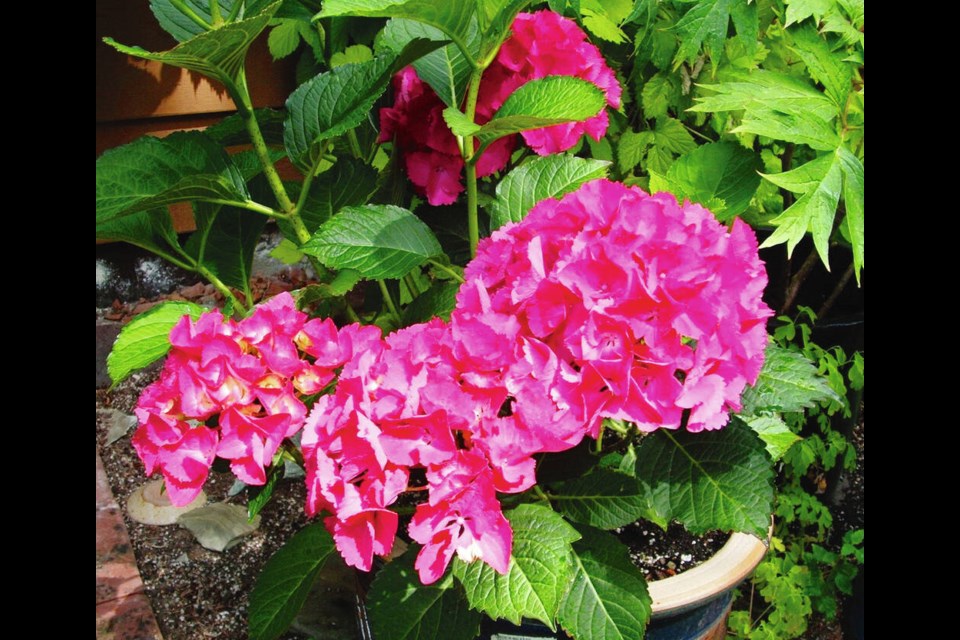Dear Helen: My hydrangea bushes need pruning. What is the preferred timing?
W.D.
From the photo you sent, your plants look like my compact bigleaf hydrangeas (Hydrangea macrophylla). You can thin them any time now. Choose a dry, mild day. Freezing temperatures are often behind us after mid-February, but not always.
First, remove at their base the most weak and spindly stems, and any that are awkwardly placed.. You can take out up to a third of the stems.
Watch for stems bearing pairs of fat, green buds. I see some in your photo. Those buds will develop into flowering growth. Make cuts immediately above the uppermost pair of substantial buds on a stem.
Dear Helen: I’ve had problems with birds raiding my pea plantings. Unless I cover a seeded plot with mesh netting, the birds dig up the seeds. Last year, after I uncovered the plants, the birds stripped the pods from the vines. This year I’m thinking of leaving the netting on until the peas have all been picked, but I’m wondering whether the flowers need pollination. I’m wondering about tomatoes as well. Do tomato flowers require flying insects to pollinate them for fruit formation?
S.M.
Both peas and tomatoes have “perfect” flowers; that is, each flower contains both male and female reproductive organs. Peas are highly self-pollinating. The flowers require no outside pollinating agents such as flying insects or wind.
The transfer of pollen in a tomato flower is aided by a slight breeze and/or insects visiting the flowers. Where neither is present, a gentle manual shaking of the plants, preferably in the morning after the pollen has had a chance to dry after overnight dews, will accomplish the transfer.
Dear Helen: The potted tomatoes in my greenhouse grow well but set very little fruit. The greenhouse becomes overheated during periods of hot weather despite shade cloth, open vents and misting several times a day. I’ve also never been sure how much to water.
R.S.
Your issue has become a major problem in the hot summers of recent years. Temperatures at and over 30 C will sterilize tomato pollen and put a stop to fruit set.
Adding a fan to your shading, misting and ventilation measures would help, but in prolonged, intense heat, in most cases the most efficient way to maintain fruit set is to move the pots to a cooler site during very hot weather.
How often and how much to water depends on variables such as the size of the pot, the water-retention quality of the potting mix and the size of the plant. It is far easier to keep the soil adequately and evenly moist in large rather than in small pots.
I plant very compact patio tomatoes in pots around 25 cm wide. Larger tomato plants need pots in the 30 to 45 cm range. I set my patio tomato pots in trays, and water into the trays after I’ve watered the soil — every day in hot weather. Lifting the pots, where possible, to sense the weight, or poking a finger into the soil are low-tech guides to moisture needs.
Some purchased planting mixes are very lightweight and have less than ideal moisture-retention capacity. Adding some hefty-textured, all-purpose potting soil enhances the “staying power” of such blends.
These days, product availability fluctuates, but my habit has been to use as the base for my potting mixes Pro-Mix BX (for “basic”) and then, for increased heft, I add about one-third as much (as the Pro-Mix) of either Island’s Finest Professional Premium Sterilized Potting Soil or Cinnabar Valley Farms Premium Organic All purpose Potting Soil. The Island’s Finest one is the heavier of the two.
For both summer and winter container plantings I usually mix in some coir (coconut fibre) as well, for its buffering ability against temperature extremes.
GARDEN EVENT
Orchid show. The Central Vancouver Island Orchid Society will be celebrating their 50th anniversary with an Orchid Show and Sale in the rotunda of Nanaimo North Town Centre, 4750 Rutherford Rd. in Nanaimo, on Friday, Feb. 17, 9:30 a.m. to 9 p.m., Saturday, Feb. 18 from 10 a.m. to 6 p.m. and Sunday, Feb. 19 from 11 a.m. to 4 p.m. Entry is free. B.C. vendors will have plants for sale. Potting workshops (by donation) will be offered on Saturday and Sunday at 1 and 3 p.m. cvios.org.



